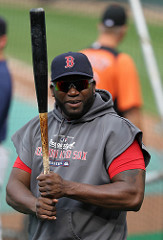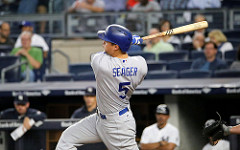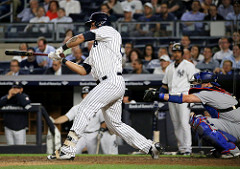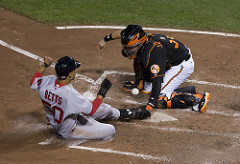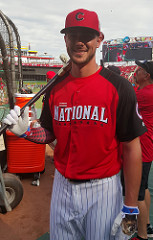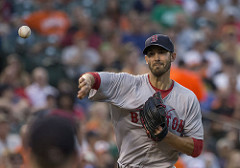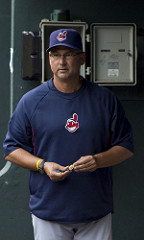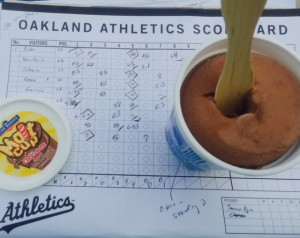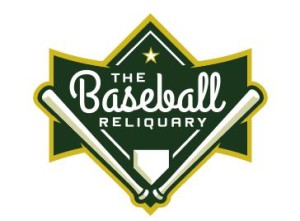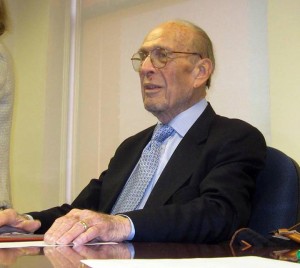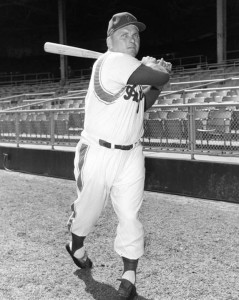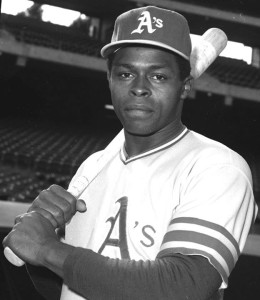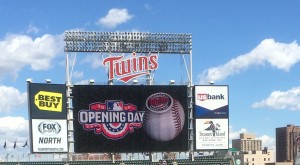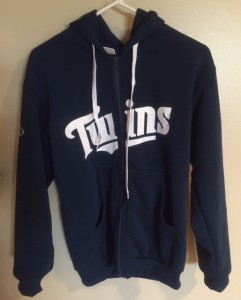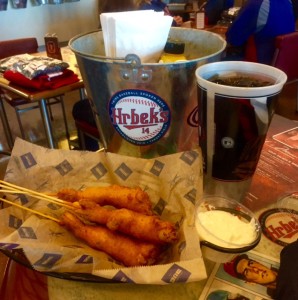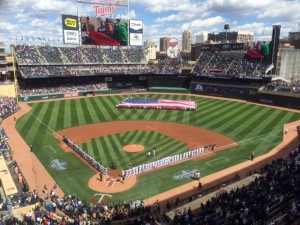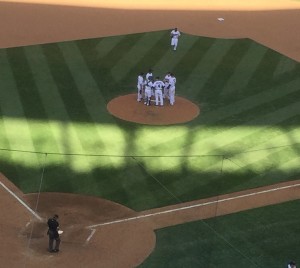Game Two of the 2016 World Series is behind us and the Indians and Cubs move on to Wrigley Field tied at a game apiece – should be one heckuva weekend in Wrigleyville!
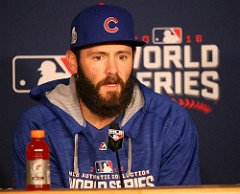
Jake Arrieta – Game Two winner. Photo by apardavila 
Yesterday’s game saw the Cubs tie the Series with a 5-1 win, finishing just ahead of the weather thanks to a one-hour early start. If you had to pick a “hero” or two, they would be: 1) Cubs starting pitcher Jake Arrieta, who got the win after taking a no-hitter into the sixth inning, giving up just one run on two hits, while striking out 6 in 5 2/3 innings; and 2) Cubs’ DH Kyle Schwarber – back after a six-month post-surgery layoff – who continued to surprise nearly everyone by collecting two hits and a walk, scoring once and droving in a pair. His role at Wrigley (he has not yet been cleared to play in the field) remains to be seen.
Here are a few random observations about Game Two.
A Rough Start for Both Pitchers
The way Game Two started out, it looked like a long night all around. The Cubs scored off Cleveland starter Trevor Bauer (who had ten stitches in his pinky finger nine days ago) just three batters into the game. After CF Dexter Fowler grounded out pitcher to first, 3B Kris Bryant singled to center and 1B Anthony Rizzo doubled him home. The Cubs’ first run of the Series came courtesy of (as they say in the Windy City) Brizzo. No more damage was done, but Bauer needed 29 pitches to get out of the inning.
Cubs’ starter Jake Arrieta pitched a scoreless bottom of the inning, but seemed to have trouble locating his pitches in the 43-degree weather. Arrieta gave up a pair of walks and threw just 10 strikes in 23 pitches. Early on, it looked like a short night for both starters.
How Do You Spell Relief?
There was plenty of work for the bullpens, as both starters ran up the pitch counts early, Cleveland starter Trevor Bauer (12-8, 4.26 in the regular season) lasted only 3 2/3 innings – giving up two runs on six hits and throwing 53 strikes in 87 pitches. Cleveland Manager Terry Francona then used six relievers to finish the contest, and they gave up three runs, two earned – on three hits and five walks – over the final 5 1/3 innings.
Jake Arrieta, the 2015 NL Cy Young Award winner (18-8, 3.10 this season) settled down after a rocky, two-walk, 23-pitch first inning. He took a no-hitter into the sixth and exited after 5 2/3 innings (one run on two hits and three walks, with six strikeouts). The Cubs’ pen (Mike Montgomery and Aroldis Chapman) outpitched the Indians’ relievers – giving up no runs on two hits and two walks, with four strikeouts over the final 3 1/3 innings. Notably, both Montgomery and Chapman were in-season acquisitions – Montgomery from the Mariners and Chapman from the Yankees.
HANK AARON AWARD
MLB yesterday announced the winners of the 2016 Hank Aaron Award for the best offensive player in each league. Your worthy pair of winners? The Red Sox’ David Ortiz in the AL and the Cubs’ Kris Bryant in the NL.
Big Papi – big bat and big smile in his final season. Photo by Keith Allison
Ortiz, in his final MLB season, had a tremendous season. As the Red Sox’ DH, he hit .315, with 38 home runs and an AL-leading 127 RBI. He also led all of MLB in slugging percentage (.620) and doubles (48), collected 80 walks and recorded a .401 on-base percentage. In the process, he set the single-season records for a player 40-years-old or older in home runs, RBI, doubles and extra base hits (Elias Sports Bureau). The Hank Aaron Award is a pretty nice – and well-deserved – retirement gift; and a great way to top a 2-yedar MLB career.
Over in the NL, the Cubs’ versatile (3B/of) Kris Bryant earned the Aaron Award. The 24-year-old Bryant, in just his second MLB season, hit .292, with 39 home runs, 102 RBI and a league-leading 121 runs scored (and threw in eight stolen bases).
A final thought/rant.: I believe MLB should add to the stature and visibility of the Hank Aaron Award by moving the announcement to after the World Series. Consider the time frame for Rookie of the Year (November 14); Manager of the Year (November 15); Cy Young Award (November 16); and MVP (November 17). I would like to see the Offensive Player of the Year (Hank Aaron Award) in that same time frame – when it would not have to compete with World Series’ hoopla and coverage.
Game Two Turning Point
There are those who may point to the Cubs’ three-run fifth as the turning point in this contest. I think that came in the top of the third after Indians’ starter Trevor Bauer, trailing 1-0, had retired Dexter Fowler and Kris Bryant and had Anthony Rizzo down no balls-two strikes. He was just a pitch away from a 1-2-3 inning. Bauer ended up walking Rizzo; LF Ben Zobrist followed with a single to center (sending Rizzo to second) and DH Kyle Schwarber slapped a single up the middle to plate Rizzo and give the Cubs a 2-0 lead. 2B Javier Baez then fanned to end the inning. What did that mean in the game?
- It ran up Bauer’s pitch count, getting the Cubs that much closer to the Indians’ pen.
- It provided Arrieta a little breathing room and a chance to settle down after early command issues.
- It gave the Cubs an emotional lift, especially since the runs was driven in by the 2016 post-season surprise player – Kyle Schwarber.
Z is for Zobrist
Veteran Ben Zobrist, who collected three hits in Game One, added a single, triple and walk in five plate appearances. He is now five-for-eight (.625), with a double and a triple in the Series. During the regular season, the 35-year-old Zobrtist hit .276, with 18 home runs, 76 RBI and 94 runs scored.
World Series Flashback
In the 1957 World Series – the first I ever attended – Milwaukee Braves’ right-hander Lew Burdette started Games Two, Five and Seven. Three starts in eight days versus a highly-favored Yankee squad that included the likes of Mickey Mantle, Yogi Berra, Elston Howard and Moose Skowron. Burdette tossed three complete games – winning all three (including shutouts in Games Five and Seven), giving up only two runs in 27 innings (0.67 ERA) Note: It appears the Indian’s Corey Kluber could pitch Games One, Four and Seven if this Series goes that far.
I tweet baseball @DavidBBRT
Member: Society for American Baseball Research (SABR); The Baseball Reliquary; Baseball Bloggers Alliance.
